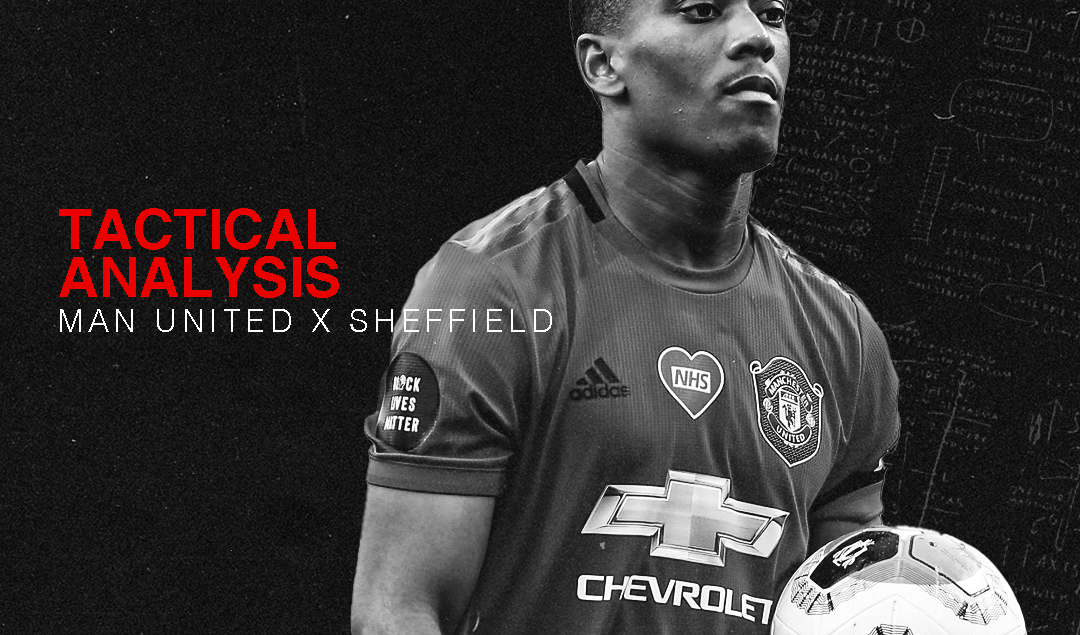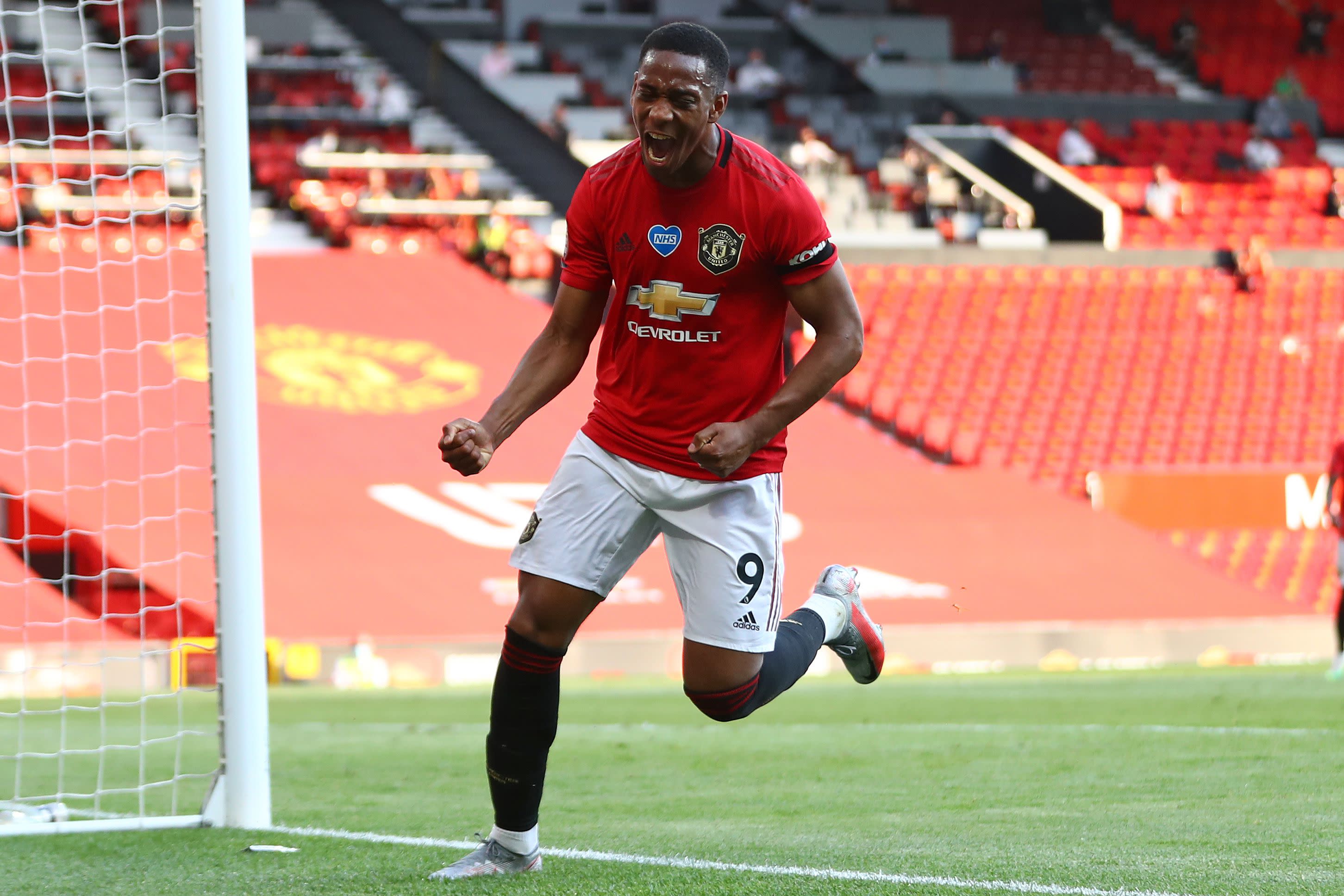Tactical Analysis: Sheffield United vs. Manchester United
In their second game since the restart of the Premier League, Manchester United welcomed Sheffield United at Old Trafford.
It was a vital match for both sides’s chances of playing European football, as the Blades, who played their third game in seven days were only two points behind United before the start of the game. Ole Gunnar Solskjaer’s side dominated Sheffield United from start to finish, grabbing all three points and keeping the pressure on Chelsea as they attempt a late push for top four.
Line-ups
While Manchester United fielded what appeared to be their strongest lineup for the first time this season, Sheffield United had to deal with two of their starters missing: John Egan and Jack O’Connell. Chris Wilder opted for Jack Robinson and ex Everton captain Phil Jagielka in their spots.
Manchester United in Possession
In order to disrupt the visitors’s shape, the Red Devils often made rotations on the left flank, and their most common pass combination (19 passes) came between Marcus Rashford and Luke Shaw.
When Shaw tucked inside, Rashford was tasked with providing width instead of staying inside like he usually does. Once Rashford was wide, Shaw often found himself in the channel between the wing-back and the outside centre-back and took the underlap to receive a well-weighted pass from Rashford in behind Sheffield’s defensive line.
When Rashford dropped deeper in the build-up, Bruno Fernandes drifted towards the left to provide triangles in wide areas. This way, Manchester United had one more passing lane to progress the ball.
However, when United had the ball in the final third, Shaw rarely stayed wide, and as a result, whenever Rashford received in the half-space, he had two or three players around him instead of just one. Shaw should’ve taken the overlap with greater regularity when Rashford found himself in the inside channel, as highlighted below.
Playing in a free role, Fernandes not only drifted to the left side to create wide overloads, but to the right as well. When on the right flank, they would lure in Sheffield United players, before passing the ball back to Paul Pogba, who switched the play to the free side.
The Frenchman made 10 long balls during the game, and nine of them reached the target. He also made 16 passes towards Shaw during the game despite playing on the right side of the pivot.
When playing on the left flank, Manchester United struggled to switch play with as much efficiency. Shaw only made one long ball and Rashford was often the one switching the play with three completed long balls. On one occasion, Harry Maguire felt the need to scream at Shaw and tell him to switch the play.
One thing that was the key to their improved build-up was Nemanja Matić’s positioning between the two centre backs. It allowed their full-backs to push higher in wide areas and connect with their wingers, as Fernandes drifted to the ball-side when they received possession. This also allowed Pogba more space to run into in the middle of the pitch.
Finally, the centre backs were wider, so the centre back on ball-side provided an extra passing lane while not being exposed in the middle of the pitch on the break. It also allowed the centre-back on the other side of the ball to provide an extra passing lane for a quick switch of play.
Whereas Manchester United struggled against Tottenham due in part to the ineffective Daniel James, the inclusion of Mason Greenwood in the starting line-up saw the English teenager receive the ball between the lines with greater success, as Aaron Wan-Bissaka often advanced into wide areas.
Going forward, Manchester United must maintain width in the final third in a more balanced manner. In the example below, Wan-Bissaka shouldn’t be as close to the box as it prevents Fernandes from finding passing lanes and allows Sheffield United’s defenders to stay compact centrally.
Manchester United off the Ball
United adopted a narrow back four with Shaw defending inside while Rashford was tasked with controlling wide areas in order to prevent the visitors from finding their wing-backs for a quick cross.
Fernandes and Anthony Martial pressed high and prevented the Blades from progressing through the middle while Pogba and Matić remained in their own half to provide control and avoid being exposed on the break. Furthermore, Rashford and Greenwood helped mark their opposite wing-back (George Baldock and Enda Stevens, respectively).
No passing options were available to Sheffield’s centre-backs, so they had to rely on long balls and United were able to easily recover. This is depicted below with Wan-Bissaka’s body orientation on the outside to prevent the ball from coming inside.
However, the press wasn’t always done as a team, which opened up space in the middle of the pitch for Sheffield United.
In this instance below, only Martial was pressing while the other forwards were lounging around, and as a result, Chris Basham was able to find an open passing option between Pogba and Fernandes.
Sheffield United in Possession
Sheffield United often pinged long balls to their left-sided striker (Lys Mousset and later David McGoldbrick) to bring the ball out the back by winning second balls.
When the hosts allowed them space in the middle of the pitch, they used short passes to find their wing-backs, or their centre backs would carry the ball out of defense. Once the ball was higher up the pitch, their players attempted to pass the ball into wide areas.
Once the ball was in wide areas, they worked with their usual overloads on both sides to carve out crossing situations.
The outside centre-back was usually underlapping to find himself behind Shaw and Maguire once Oli McBurnie attracted Maguire further away from the goal. McBurnie would then find Basham for the centre-back to deliver a cross.
Sheffield United off the Ball
Sheffield United’s wide overloads almost cost them twice on the break in the first 15 minutes. First, it was Greenwood who decided to shoot. Then, it was Rashford receiving the ball and finding Martial on the break. In both cases, these chances came in wide areas.
Operating in a 5-3-2 shape, Wilder’s men decided to not be aggressive in wide areas or in midfield during the first half. In the second half, the wing-backs focused on pressing their opposite full-backs, and as a result, didn’t have enough time to find their teammates in space in the middle of the pitch.
The middle centre-back in the back three (usually Jagielka) often pressed the forward who received in between the lines. Martial drew players out when he dropped deeper as the center back would follow him. They played into Manchester United’s hands in that regard, by enabling United’s wide overloads.
Individual Player Reports
Paul Pogba
Pogba always picked the right pass in build-up and kept things simple. During the first half, Matić dropped deep which allowed him to play as a lone pivot and have more space to run into, receive the ball, and find his teammates in dangerous areas.

Photo: Getty
When he was in the final third, he was still able to create danger, as seen with his through ball to Rashford in the 19th minute and constant switches of play to the free man.
He also found Fernandes 11 times in between the lines, which helped United sustain possession in the opponent’s half as the Blades had to drop deeper to contain him. The Frenchman was pivotal in Manchester United’ strategy who was able to overload one side and quickly find his teammate on the underloaded side.
His relationship with Martial hasn’t changed one bit even with his injury and the lockdown. Pogba was still able to find his compatriot when the latter dropped in between the lines to create overloads.
Bruno Fernandes
The best thing about Fernandes’s performance was his improved decision-making, with the Portuguese taking fewer risky shots. For Martial’s second goal, instead of taking a shot, he decided to pass the ball to Pogba on the right, who passed it to Wan-Bissaka who made the assist to Martial.

Photo: Getty
Fernandes drifted towards the ball side to create overloads through triangles and provide extra passing option for the ball-carrier. He also showed signs of improvement in his positioning; if the ball-side was already overloaded, he retreated to the other side provide a passing option to Pogba in the middle of the pitch, which helped United move the opposition from one side to another while keeping Martial in advanced positions.
He was dispossessed 23 times, but this is because he always tried to find teammates who were making runs. A high-risk/high-reward player, Fernandes’s movement and positional awareness outweigh his tendency to lose the ball.
Anthony Martial
Fernandes’s higher positioning allowed Martial to drop deeper less, enabling him to make more runs in behind the defensive line. It also allowed him to remain near the the box waiting for passes to arrive, making Sheffield United’s defensive line drop deeper and allowing his teammates to overload the box.
Photo: Michael Steele/Getty Images
Martial was still able to drop deep to create overloads on wide areas, whether it was on the right or on the left, leaving a teammate alone on the unloaded side to allow quick switches of play. He scored three goals from a total xG of 1.33, a testament to his superb finishing.
Defensively, he also led the press for his team, dragging Sheffield United’s centre backs out wide so his teammates could activate pressing triggers more easily.
By: @JKRegista
Featured Image: @GabFoligno

